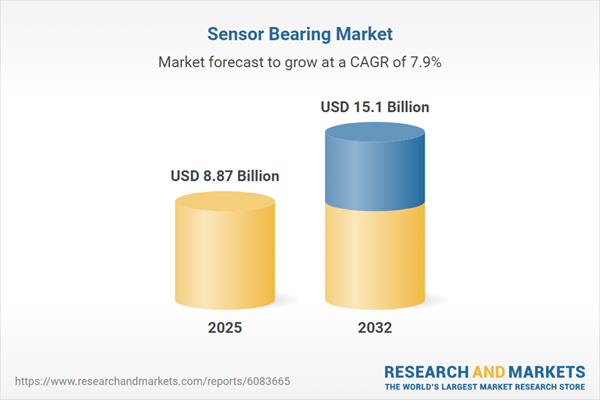Speak directly to the analyst to clarify any post sales queries you may have.
The sensor bearing market is experiencing profound transformation, with technological advancements and dynamic industry shifts redefining asset monitoring and predictive maintenance benchmarks for diverse sectors.
Market Snapshot: Sensor Bearing Market Size and Growth
The Sensor Bearing Market grew from USD 8.23 billion in 2024 to USD 8.87 billion in 2025. It is expected to continue growing at a CAGR of 7.88%, reaching USD 15.10 billion by 2032. This expansion is propelled by the increasing adoption of embedded sensing technologies, robust demand from digitalized industrial environments, and regulatory priorities centered on operational safety and efficiency.
Scope & Segmentation of the Sensor Bearing Market
- Product Types: Angular contact bearings, cylindrical roller bearings, deep groove bearings, spherical roller bearings, and tapered roller bearings.
- Material Types: Ceramic, chrome, hybrid, and steel compositions.
- Industry Verticals: Aerospace, automotive (including commercial vehicles, electric vehicles, passenger vehicles), consumer electronics, healthcare, and industrial machinery (comprising agricultural, construction, and mining segments).
- End Users: Aftermarket (automotive and electronics) and OEM (automotive, electronics, and industrial).
- Distribution Channels: Offline and online platforms.
- Regional Coverage: Americas (United States, Canada, Mexico, Brazil, Argentina, Chile, Colombia, Peru), Europe, Middle East & Africa (including United Kingdom, Germany, France, Russia, Italy, Spain, Netherlands, Sweden, Poland, Switzerland, United Arab Emirates, Saudi Arabia, Qatar, Turkey, Israel, South Africa, Nigeria, Egypt, Kenya), and Asia-Pacific (China, India, Japan, Australia, South Korea, Indonesia, Thailand, Malaysia, Singapore, Taiwan).
- Company Developments: This analysis includes AB SKF, Schaeffler Technologies AG & Co. KG, NSK Ltd., NTN Corporation, The Timken Company, JTEKT Corporation, MinebeaMitsumi Inc., RBC Bearings Incorporated, Regal Rexnord Corporation, and Kaman Corporation.
Key Takeaways for Senior Decision-Makers
- Sensor bearings integrate sensing functionality directly within traditional bearing assemblies to enable real-time monitoring, strongly supporting predictive maintenance frameworks in critical industrial assets.
- Technological evolution, such as edge computing and embedded machine learning, is rapidly improving anomaly detection, reducing unexpected downtime, and shaping automation protocols for industrial, transportation, and healthcare sectors.
- Regulatory shifts and sustainability pressures are influencing the move toward eco-efficient materials, such as hybrid ceramic composites and advanced coatings, aligning with energy efficiency and long-term cost optimization strategies.
- Geopolitical trends, including tariffs and global supply chain realignment, encourage diversified sourcing, greater supply chain transparency, and collaborative risk-sharing models to reduce operational interruptions.
- Regional specialization, particularly in advanced manufacturing and electrified transportation, contributes to localized product demands and collective innovation through research consortia and trade agreements.
Tariff Impact: Navigating U.S. Trade Duty Implications
Recent trade duties on imported sensor bearing inputs, especially in the U.S., have raised procurement costs and provoked adjustments in sourcing strategies. OEMs now focus on supply base diversification and renegotiations, with service providers expanding value-added offerings to cushion price increases. Supply chain resilience has become a strategic priority, necessitating bonded warehousing, dual sourcing, and agile logistics planning to maintain throughput and quality standards.
Methodology & Data Sources
This research integrates desk-based analysis with structured expert interviews, leveraging input from manufacturers, end users, and consultants. Data undergoes triangulated validation, cross-referenced against multiple sources, and subject to rigorous quality controls for accuracy. Ethical standards and confidentiality frameworks govern the entire data collection and reporting process.
Why This Report Matters
- Enables informed strategic decisions by delivering up-to-date insights on sensor bearing market dynamics, technology innovation, and segment-specific opportunities.
- Supports risk management and investment planning with deep dives into regulatory, supply chain, and regional factors affecting operational continuity.
- Provides grounded guidance for product development and partnership strategies, equipping leaders to prioritize sustainability and competitive positioning.
Conclusion
The sensor bearing market is evolving in response to rapid digitalization, technological innovation, and complex global supply scenarios. Well-informed leadership and agile responses to shifting demands and policies will determine competitive advantage in this critical sector.
Table of Contents
3. Executive Summary
4. Market Overview
7. Cumulative Impact of Artificial Intelligence 2025
Companies Mentioned
The companies profiled in this Sensor Bearing market report include:- AB SKF
- Schaeffler Technologies AG & Co. KG
- NSK Ltd.
- NTN Corporation
- The Timken Company
- JTEKT Corporation
- MinebeaMitsumi Inc.
- RBC Bearings Incorporated
- Regal Rexnord Corporation
- Kaman Corporation
Table Information
| Report Attribute | Details |
|---|---|
| No. of Pages | 189 |
| Published | November 2025 |
| Forecast Period | 2025 - 2032 |
| Estimated Market Value ( USD | $ 8.87 Billion |
| Forecasted Market Value ( USD | $ 15.1 Billion |
| Compound Annual Growth Rate | 7.8% |
| Regions Covered | Global |
| No. of Companies Mentioned | 11 |









